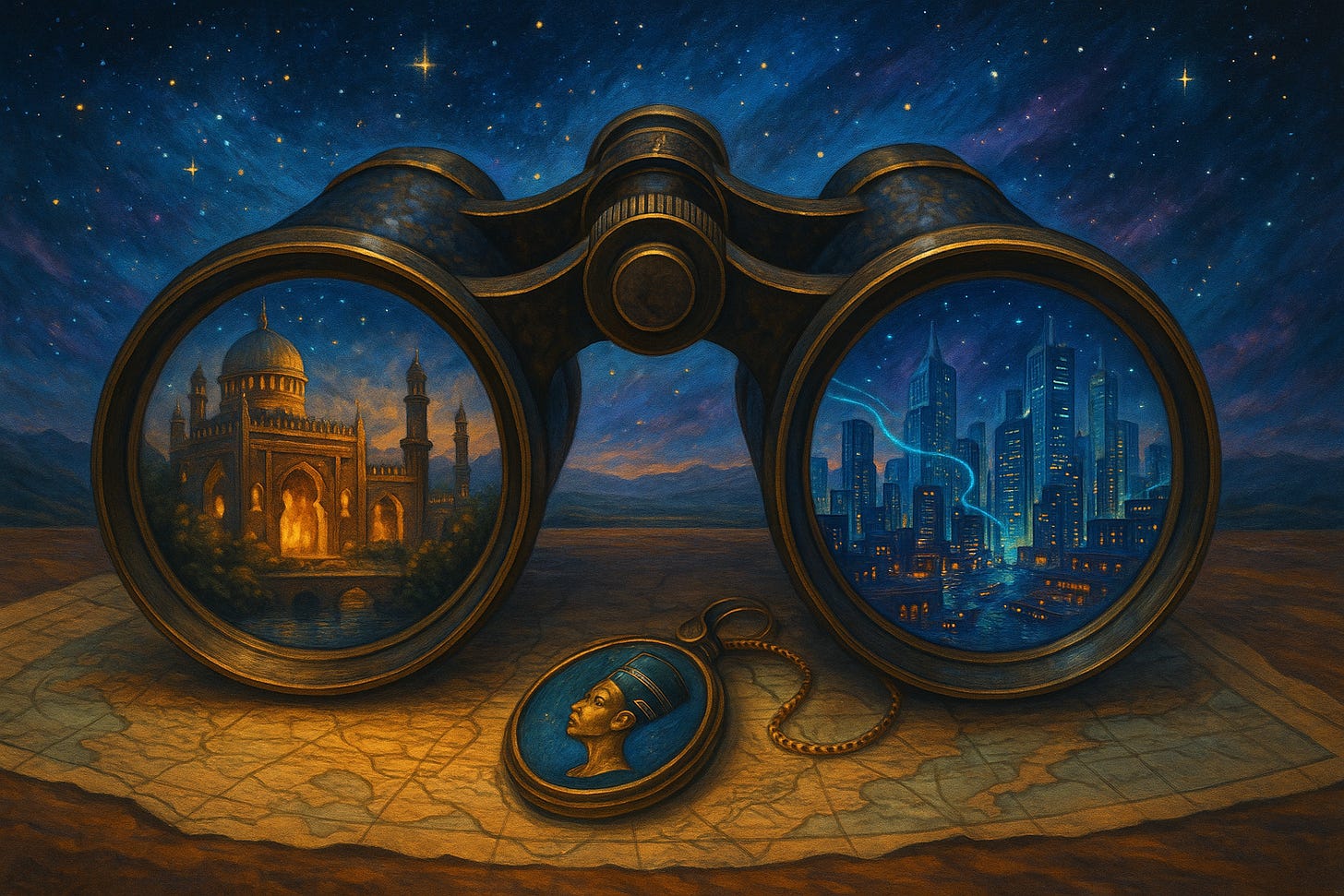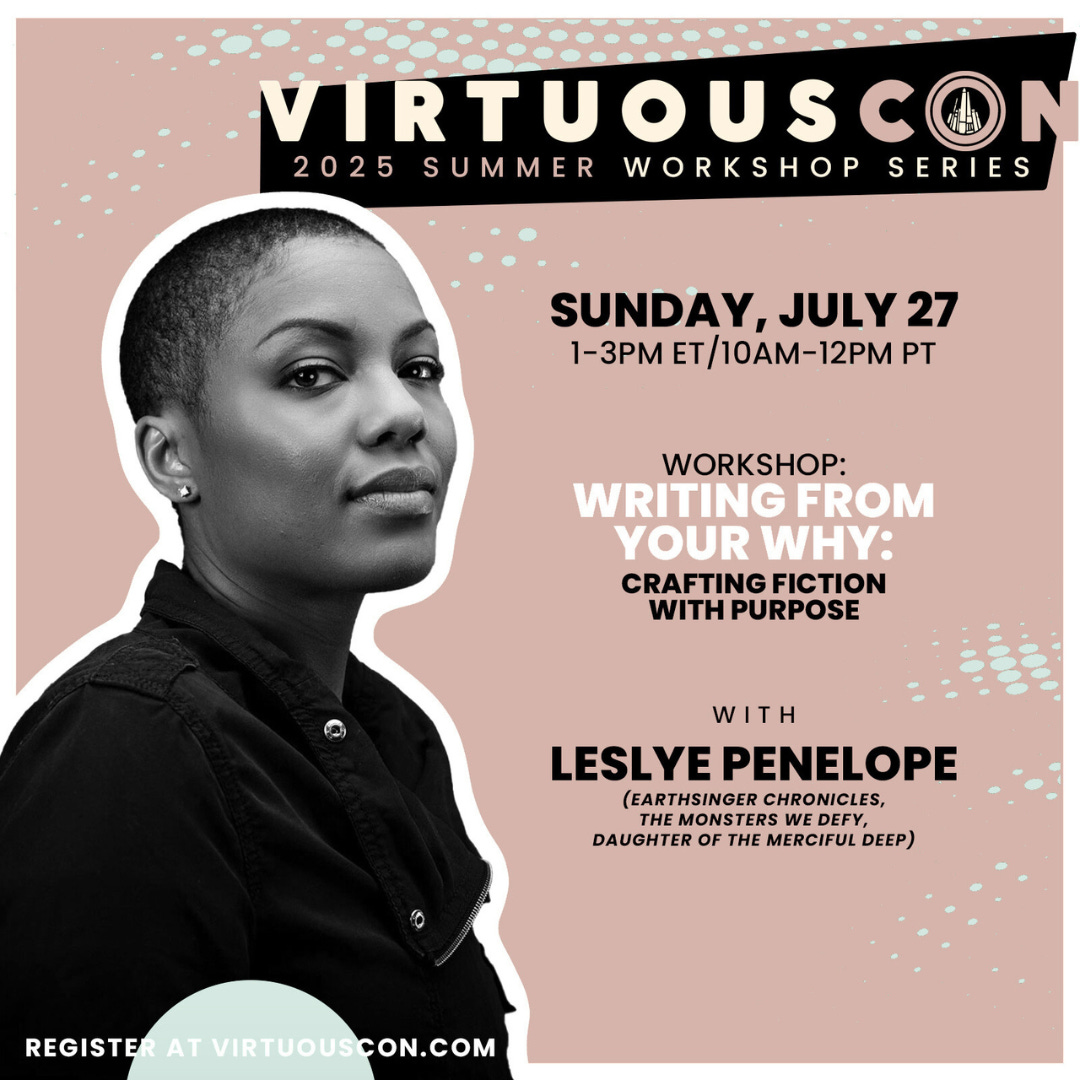Building Worlds: What Matters, What Divides, and Whose Eyes We See Through
Part 3 of 4 - Worldbuilding for Every Story
This is the third post in my series on worldbuilding across genres. In the previous posts, we explored why worldbuilding matters for all fiction writers, not just fantasy & sci-fi writers, and the first two essential worldbuilding questions: where to start and why your story needs its specific setting.
Today, we'll examine the remaining three questions that complete our worldbuilding framework.
But first, I have a special announcement!
What’s the story only you can tell?
Join me for a special live workshop with Virtuous Con where we’ll uncover your creative "why" and turn it into purpose-driven fiction that truly connects.
Sunday, July 27 | 1–3 PM ET - $29.99
Inside every storyteller is a spark: a question that won’t let go, a truth waiting to be uncovered. In this workshop, you’ll learn to identify your unique “why” and channel it into fiction that feels deeply purposeful and powerfully resonant.
This is a space for writers who aren’t interested in writing to market trends or trying to mimic what’s already successful. You want to find an audience while crafting stories that entertain and also come from your heart—stories that matter to you, and in doing so, reach the readers who will connect with them most.
Whether you write fantasy, romance, science fiction, or anything in between, you’ll walk away with clarity about the stories only you can tell, along with the tools to write them with purpose, authenticity, and heart.
Can’t make the live workshop? No problem! All ticket holders will receive a recording of the full workshop and Q&A.
Question #3: What Do People Value and Cherish?
Understanding what your characters care about gives them their motivation for taking action and makes their actions believable. While some motivations are universal across human experience—love, safety, belonging—your story will be more unique and memorable when these are viewed through the lens of your specific world.
Every society, real or fictional, has things it holds sacred and things it considers taboo or profane. These values create the moral landscape your characters navigate. Ask yourself:
What does this society worship or revere?
What rituals or traditions are considered essential?
What behaviors would shock or scandalize people?
What beliefs are widely accepted without question?
Your protagonists will either adhere to these values or rebel against them—and this choice defines them as characters.
In the Netflix series Queen Charlotte, the titular character is forced into marriage with the King of England by her older brother. The world they inhabit gives her brother this power regardless of her wishes. Her initial rebellion against this system, followed by her navigation within it, defines her character arc.
In Fight Club, Tyler Durden rebels against consumerism by creating an underground fight club. His rejection of societal values drives the entire film (and, I assume, the book though I haven’t read it).
In The Hunger Games, Katniss Everdeen takes small but significant actions to show her rebellion against the Capitol's games, ending in a major act of defiance at the end of the first book.
What Makes a Protagonist?
Often what makes a character a protagonist is precisely the fact that they don't simply accept the status quo. It would be difficult to build a compelling story around a character who is just content with everything in their world and living a great life with no challenges.
When building your main character, ask yourself:
What aspect of your world does your protagonist fight against?
Which values do they reject or question?
What sacred cow are they willing to slaughter?
Or conversely, what tradition are they fighting to preserve that others want to destroy?
The tension between individual values and societal norms creates rich territory for character development.
Question #4: How Do Characters Come Into Conflict?
This is about what tears people apart, conflict, the essential ingredient of all fiction. As someone who's naturally conflict-averse in real life, I had to learn to be comfortable with creating fictional conflict. Without it, you simply don't have a story.
Consider how these worldbuilding elements might generate authentic conflict:
Conflicting Values: What happens when characters with fundamentally different beliefs must work together or live in proximity?
Inequitable Resource Distribution: Who has access to wealth, education, magic, technology, or other resources? Who doesn't, and why?
Historical Grievances: What past events have created lasting animosity between groups?
Outsider Status: Who is marginalized in this society? What happens when these outsiders seek inclusion or justice?
Expectation vs. Reality: What happens when a character's expectations (shaped by their background) clash with the reality they encounter?
The Netflix movie Purple Hearts features a liberal musician and a conservative soldier (red + blue = purple) in a marriage of convenience. Their political differences create genuine obstacles they must overcome.
In Pride and Prejudice, the conflict stems partly from resource distribution—Mr. Darcy has wealth and privilege while Elizabeth Bennett faces potential poverty due to inheritance laws that leave her and her sisters out in the cold in favor of their male cousin who will inherit everything upon her father’s death.
In my epic fantasy series "Earthsinger Chronicles," two nations fight over resources, but the conflict is complicated by a magic barrier and centuries of hatred. The personal conflicts between characters mirror these larger societal tensions.
Building Richer Conflicts
To deepen the conflicts in your story, ask:
What is the historical basis for antagonism between groups?
What misconceptions do characters have about each other?
What systems perpetuate the conflict?
What would need to change for reconciliation to occur?
What personal costs do characters face if they challenge the status quo?
Remember that the most compelling conflicts aren't simply good versus evil—they evolve organically from competing values, needs, and aspirations that all have some validity.
Question #5: Who Is Telling the Story?
This final question bridges worldbuilding and craft: How do you reveal your carefully constructed world to readers in a way that's engaging rather than overwhelming?
Reveal World Through Character
The most effective technique, in my opinion, is to reveal your world through the eyes of your characters using deep point of view (POV). Have the reader learn about the world as the character does, seeing it through their specific lens.
This approach helps avoid the dreaded "info dump"—those pages of exposition that explain everything that’s ever happened since the beginning of your world. Different genres have different tolerances for exposition (epic fantasy readers expect more of it than thriller readers), but generally, showing the world through character’s experience of it is more engaging than explaining it directly.
Consider how different characters would perceive the same environment:
A native New Yorker walking down Fifth Avenue might be annoyed by a taxi cutting them off, but wouldn't stare in awe at the skyscrapers they've seen their entire life.
A newcomer from rural Iowa might be overwhelmed by the noise, the crowds, the height of the buildings—their perspective would focus on entirely different details.
This difference in perspective doesn't just reveal setting—it reveals character. What your characters notice, what they ignore, and how they interpret their surroundings tells us who they are.
Your character's occupation, interests, and background also act as a filter for how they perceive the world:
A painter might notice colors, light, and composition
An architect might focus on building design and materials
A soldier or police officer might assess threats and defensive positions
A gardener might identify every plant they pass or wonder at ones they don’t recognize
By showing the world through this filter, you accomplish two things at once: building your world and developing your character.
I like to always make my worldbuilding do multiple jobs at once. Why waste words? So when you're revealing a character’s backstory or history, try do as many of these as you can reasonably accomplish:
Reveal character
Show relationships
Describe the physical setting
Plant seeds for future conflicts
Establish mood or tone
For example, if your character always wears purple because their grandmother (who raised them) loved that color, this detail can reveal family history, character loyalty, and emotional connection—all while describing what they're wearing.
Bringing It All Together
These five questions form a framework for building a world that feels authentic and integral to your story, regardless of genre:
Where do we start? (Establish the foundations)
Why is this the only place for the story? (Make your world irreplaceable)
What do people value? (Define cultural elements)
How do characters conflict? (Create tension from worldbuilding)
Who tells the story? (Reveal through character perspective)
By considering these factors, you'll create a world that doesn't just hold your story but enables and enriches it—a world that readers will want to return to again and again.
Coming Next
In the final post in this series, we'll explore practical techniques for weaving your world into your narrative without overwhelming readers. I'll share specific strategies for balancing exposition with action, keeping readers engaged while building a rich world, and resources to take your worldbuilding to the next level.
Want more guidance on worldbuilding? Download my free worldbuilding checklist from the subscriber library which includes access to my creative toolkit with story development workbooks, character templates, and more.



